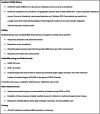Ward-delivered nasal high-flow oxygen and non-invasive ventilation are safe for people with acute respiratory failure: a cohort study
- PMID: 39797627
- PMCID: PMC11981030
- DOI: 10.1111/imj.16624
Ward-delivered nasal high-flow oxygen and non-invasive ventilation are safe for people with acute respiratory failure: a cohort study
Abstract
Background and aims: Ward-delivered non-invasive respiratory supports (NIRS) (conventional oxygen therapy (COT), high-flow nasal oxygen (HFNO), continuous positive airway pressure (CPAP) and non-invasive ventilation (NIV)), are often used to treat hospitalised patients with acute respiratory failure (ARF) both in high acuity and general wards. This study aimed to describe the processes of care adopted and examine patient outcomes from a specialist, ward-delivered NIRS service caring for people with COVID-19 in general wards or in a respiratory care unit (RCU).
Methods: A cohort study was undertaken including all consecutive patients admitted to a quaternary hospital with ARF secondary to COVID-19 and requiring ward-delivered NIRS between 28 February 2020 and 18 March 2022. NIRS use, processes of care and patient outcomes were examined.
Results: Six hundred sixty-eight patients were included, with 61% male and a mean age of 64 years (interquartile range 48-79 years). All received COT. Fifty eight percent of patients required additional NIRS: HFNO (36.2%), CPAP (19.8%) and NIV (1.9%). Eighty-two percent of patients had oxygen saturation targets documented. After the implementation of the RCU, significantly more nurse consultant-led CPAP prescriptions were initiated (P = 0.004) and fewer patients required review by the ICU team (P = 0.001) or transfer to ICU (P = 0.050). Forty-nine patients died (7.3%), with most (62.8%) being discharged directly home.
Conclusion: This study highlights that ward-delivered NIRS is feasible and safe for people with COVID-19 and ARF. The combination of ward and RCU-delivered NIRS was particularly effective. Further research is required to determine the optimal models of respiratory care required for a broader range of patients and to understand how these should be implemented.
Keywords: acute respiratory failure; models of care; nasal high‐flow oxygen; non‐invasive respiratory support; non‐invasive ventilation; oxygen.
© 2025 The Author(s). Internal Medicine Journal published by John Wiley & Sons Australia, Ltd on behalf of Royal Australasian College of Physicians.
Figures


References
-
- Plant PK, Owen JL, Elliott MW. Early use of non‐invasive ventilation for acute exacerbations of chronic obstructive pulmonary disease on general respiratory wards: a multicentre randomised controlled trial. Lancet 2000; 355: 1931–1935. - PubMed
-
- Mansfield DR. Nasal high‐flow therapy: established roles and emerging opportunities. Respirology 2019; 24: 1039–1041. - PubMed
-
- Parker K, Perikala V, Aminazad A, Deng Z, Borg B, Buchan C. Models of care for non‐invasive ventilation in the acute COPD comparison of three tertiary hospitals (ACT3) study. Respirology 2018; 23: 492–497. - PubMed
Publication types
MeSH terms
LinkOut - more resources
Full Text Sources
Medical
Miscellaneous

